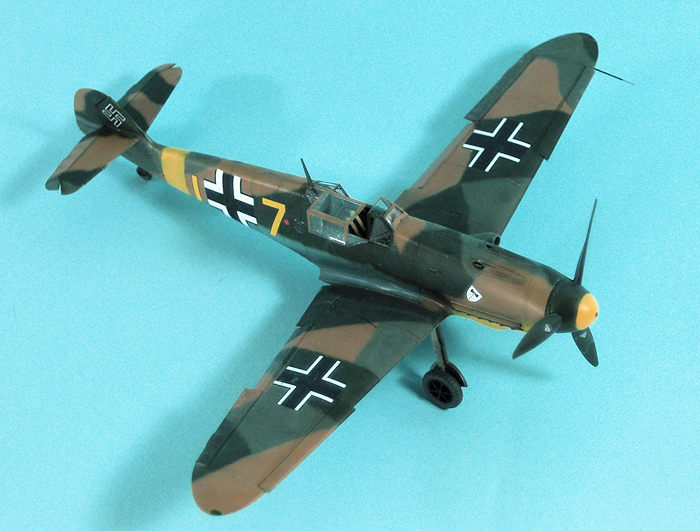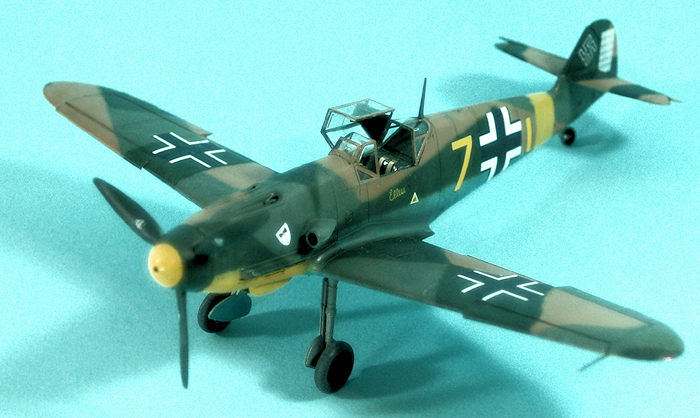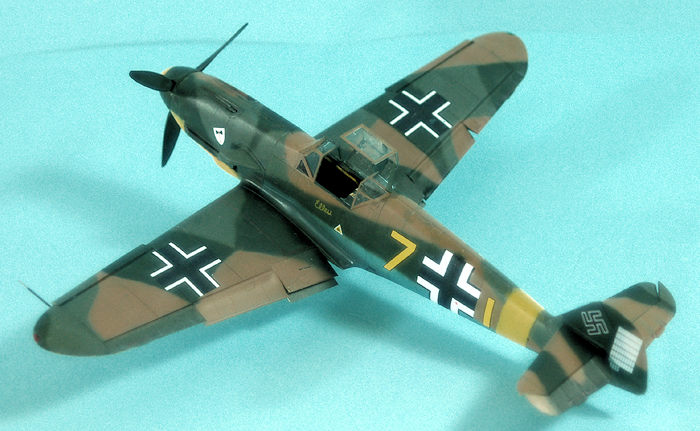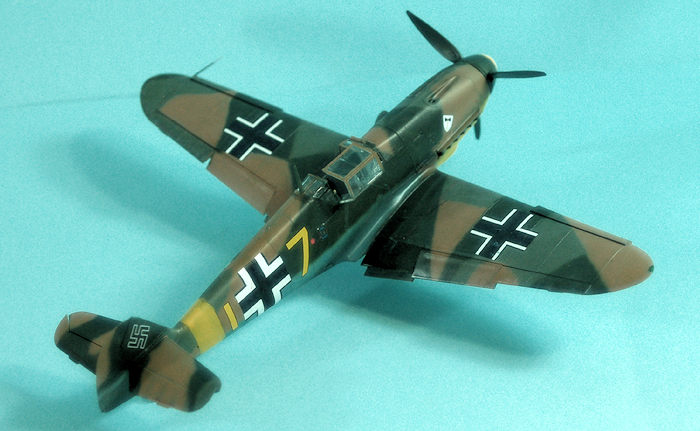
Eduard 1/48 Bf-109F-4
| KIT #: | 82114 |
| PRICE: | $49.95 |
| DECALS: | Six options |
| REVIEWER: | Tom Cleaver |
| NOTES: | Profipack |

| HISTORY |
The Bf 109F Friedrich series is commonly considered the best of the 109 series. It had the best combination of power, weapons and maneuverability of the entire series. The later Gustav and Kurfurst series of 109s did not see performance increases that were the equal of the aerodynamic penalties they imposed in terms of weight and overall performance. In his book, “I Flew For The Fuhrer,” Heinz Knoke pointed out that due to its weight penalty, the Gustav series had to be flown at full throttle while in the landing pattern with gear and flaps down.
The
Friedrich
series was an attempt to completely improve the Bf 109 in terms of all flight
regimes to take full advantage of the increased power available from the DB601E
and DB601N engines during its production life. With development commencing in
the Spring of 1940, the
Friedrich
was primarily distinguished from the previous Bf 109E series by the refined,
more aerodynamically streamlined symmetrical cowling. The supercharger air
intake was redesigned and positioned further out from the cowling to increase
the ram effect. The wing was modified by having the slotted ailerons replaced by
Frise type ailerons of slightly less span and greater chord. Armament was
modified by removing the wing mounted 20mm cannons and replacing these with a
cannon mounted on the centerline firing through the airscrew hub. Originally a
20mm MG FF was used on the Bf 109F 1; this was changed to a 15mm
 MG151 from the
Bf 109F 2, and finally to a 20mm MG151 on the Bf 109F 4. The Bf 109F 1 and F 2
were powered by the DB601N of 1,175 h.p., with the 1.350 h.p. DB 601E introduced
on the Bf 109F 3.
MG151 from the
Bf 109F 2, and finally to a 20mm MG151 on the Bf 109F 4. The Bf 109F 1 and F 2
were powered by the DB601N of 1,175 h.p., with the 1.350 h.p. DB 601E introduced
on the Bf 109F 3.
The first Bf 109Fs, which were likely pre production Bf 109F 0s, were sent to JG 51 in early October 1940. Geschwader Kommodore Werner Mölders and his stab flight being provided these aircraft. He scored his 43rd victory in a Bf 109F 0 on October 11, 1940, and another two Spitfires on October 25.
While Mölders became the leading exponent of the new Bf 109, Oberstleutnant Adolf Galland of JG 26 and Major Walter Oesau of JG 3 refused to fly the airplane, considering it a “retrograde” development for its reduced armament. Galland argued that while an outstanding shot like himself or Mölders could use the centerline armament, the average squadron pilot needed the additional weight of fire of two 20mm cannon in the wings to maximize the opportunity for success. Both Galland and Oesau refused to fly the airplane while there were parts for their Bf 109Es, and Galland didn’t relent until the late Spring of 1941 when two special Bf 109F 6s were specifically created for him: one with two 13mm machine guns in the engine cowling and a 20mm MG151, and one with two 20mm MG FF cannons in the wings.
In the meantime, the Bf 109F suffered structural failures commencing in February 1941, with several unexplained crashes of otherwise competent pilots who entered dives and were unable to pull out successfully. This was eventually traced to the fact that the Friedrich series had dropped the external braces of the horizontal stabilizer used by all previous versions. This was accompanied by the use of stronger but less ribbing in the tail, which altered the proportion of rigidity to the strength of the tail. The result was that the tailplane had a frequency of oscillation that was overlapped by the engine at certain rpm’s, and the resultant sympathetic vibrations tore out the tail spars.
With this fault remedied, the Geschwader on the Channel Front began rapid re equipment with the Friedrich commencing in March 1941. By May, very few Bf 109Es were left there. The Friedrich came as a nasty surprise to the RAF, which had only just managed to come up with a Spitfire that had a higher performance than the Bf 109E by the introduction of the Spitfire V. Once again, the Spitfire and the Bf 109 were so evenly matched that pilot skill was the deciding factor, and in this the Germans were superior at the time.
Viktor Bauer:
 One of the more
successful, but still a lesser known
experte
to fly the
Friedrich
was Viktor Bauer. Bauer joined the Luftwaffe in 1936, and was assigned to JG 2
upon completion of training. He moved on to JG 77 in March 1940 and served with
1st Staffel
through the French campaign and the Battle of Britain. He was transferred to
9th Staffel
of JG 3 in November 1940, by which time he had three victories. In June , 1941,
just before the invasion of Russia, he was promoted to
Staffelkapitän
of 9.JG 3, with 4 victories total.
One of the more
successful, but still a lesser known
experte
to fly the
Friedrich
was Viktor Bauer. Bauer joined the Luftwaffe in 1936, and was assigned to JG 2
upon completion of training. He moved on to JG 77 in March 1940 and served with
1st Staffel
through the French campaign and the Battle of Britain. He was transferred to
9th Staffel
of JG 3 in November 1940, by which time he had three victories. In June , 1941,
just before the invasion of Russia, he was promoted to
Staffelkapitän
of 9.JG 3, with 4 victories total.
Bauer’s star began to shine on the Eastern Front. In June 1941 he shot down 15 Soviet aircraft, including 5 SB 2s on June 26. July saw him claim 17 victories, including five DB 3 twin engine bombers on July 12. By then promoted to Oberleutnant, Bauer was awarded the Ritterkreuz on July 30 for 36 victories. Wounded in combat with Soviet bombers on July 23, Bauer made an emergency landing. With wounds serious enough to spend several months in hospital, Bauer returned to combat February 1942, and claimed his 40th victory on February 18, with number 50 on April 4. He shot down 4 I 16s in one combat on May 22. Flying a Bf 109F 4, Bauer was spectacularly successful during July, 1942, when he claimed a total of 33 victories. He shot down four in a day five times and twice recorded five victories in a day. On July 26 he was awarded the Eichenlaub for scoring 102 victories. On August 9, he scored his 106th and final victory, but was wounded in action a day later. Following his recovery from wounds, Bauer was appointed a Staffelkapitän in Ergänzungs Jagdgruppe Ost. Major Bauer was appointed Gruppenkommandeur of Ergänzungs Jagdgruppe Ost in July 1943, a position he held until November 1944. On December 1, 1944, Oberst Bauer was appointed Kommodore of Ergänzungs Jagdgruppe 1, which position he held until the end of the war.
Viktor Bauer was credited with 106 victories in 400 missions. His 102 victories on the Eastern front included 27 Il 2 Sturmoviks.
| THE KIT |
 Eduard announced in
2014 they were going to do the “definitive” series of Bf-109s. Having already
done the Bf-109e, they released a Bf-109G that nearly wrecked them. It was
withdrawn and a re-designed kit that fully met their claim of being “definitive”
was released earlier this year. The Bf-109F-4 was released in early October as
the second major release in the series. It fully lives up to the expectations
created by the Bf-109G-6 kit.
Eduard announced in
2014 they were going to do the “definitive” series of Bf-109s. Having already
done the Bf-109e, they released a Bf-109G that nearly wrecked them. It was
withdrawn and a re-designed kit that fully met their claim of being “definitive”
was released earlier this year. The Bf-109F-4 was released in early October as
the second major release in the series. It fully lives up to the expectations
created by the Bf-109G-6 kit.
The Profipack kit provides markings for six interesting schemes for the Friedrich, along with the standard Profipack photoetch detailing.
| CONSTRUCTION |
 The kit has very
precise design. If a modeler is careful to completely clean off any sprue nubs
from removing a part from the sprue tree, it is possible to assemble this kit
without having to use any filler anywhere. Any need of filler is due to a
modeler-induced problem, not the kit.
The kit has very
precise design. If a modeler is careful to completely clean off any sprue nubs
from removing a part from the sprue tree, it is possible to assemble this kit
without having to use any filler anywhere. Any need of filler is due to a
modeler-induced problem, not the kit.
Take care in determining which airplane you are going to do, so you use the proper spinner, air intake and oil cooler radiator. The kit only provides the late pilot’s seat, which means that only the Bf-109F-4/Trop options can be done in full confidence that the seat used is right for the specific airplane. It is not hard to modify the seat with Evergreen sheet to create one of the two earlier seats.
Following the instructions and taking care in assembly will result in a “perfect” model out of the box. There are no “secrets” and no hidden problems in the design of the kit to give any difficulty in assembly.
| COLORS & MARKINGS |
 I decided to do one
of the Eastern Front options where the airplanes were originally delivered in
desert camouflage and were repainted in the field. I used Xtracrylix paints to
freehand the camouflage. Eduard’s painting and markings diagrams are excellent
since they show both sides of the fuselage as well as upper and lower views.
I decided to do one
of the Eastern Front options where the airplanes were originally delivered in
desert camouflage and were repainted in the field. I used Xtracrylix paints to
freehand the camouflage. Eduard’s painting and markings diagrams are excellent
since they show both sides of the fuselage as well as upper and lower views.
I used the kit decals to do Viktor Bauer’s 9./JG 3 airplane. They went down without any difficulty under a coat of Micro-Sol.
I made some exhaust staining, then unmasked the caopy and assembled it in the open position, then attached the landing gear and other small items.
| CONCLUSIONS |
 This is a really excellent kit that is highly accurate. The previous
most-accurate Bf-109f kit is that by Zvezda, which provides the option of a full
engine compartment with the cowling assembled separately. The Eduard kit is far
less “fiddly” in assembly than the Zvezda, but that is the only real difference
quality-wise. The Zvezda kit provides more options in the box, since the Eduard
kit only has the cowling-closed option. The Zvezda kit costs about half the MSRP
of the Eduard kit, though there are bargains to be found that reduce price by
around $12-$15 off MSRP. I am sure modelers will be buying overtrees to make
other kits to make full use of the really nice markings options provided in the
Profipack kit. I have repeatedly said I am “109ed out,” and then Eduard comes
along and releases another excellent kit. The kit will allow anyone who has some
experience of assembling plastic kits to produce a masterpiece out of the bos.
Highly recommended.
This is a really excellent kit that is highly accurate. The previous
most-accurate Bf-109f kit is that by Zvezda, which provides the option of a full
engine compartment with the cowling assembled separately. The Eduard kit is far
less “fiddly” in assembly than the Zvezda, but that is the only real difference
quality-wise. The Zvezda kit provides more options in the box, since the Eduard
kit only has the cowling-closed option. The Zvezda kit costs about half the MSRP
of the Eduard kit, though there are bargains to be found that reduce price by
around $12-$15 off MSRP. I am sure modelers will be buying overtrees to make
other kits to make full use of the really nice markings options provided in the
Profipack kit. I have repeatedly said I am “109ed out,” and then Eduard comes
along and releases another excellent kit. The kit will allow anyone who has some
experience of assembling plastic kits to produce a masterpiece out of the bos.
Highly recommended.
26 October 2016
Copyright ModelingMadness.com
Thanks to my billfold for the review kit.
If you would like your product reviewed fairly and fairly quickly, please contact the editor or see other details in the Note to Contributors.